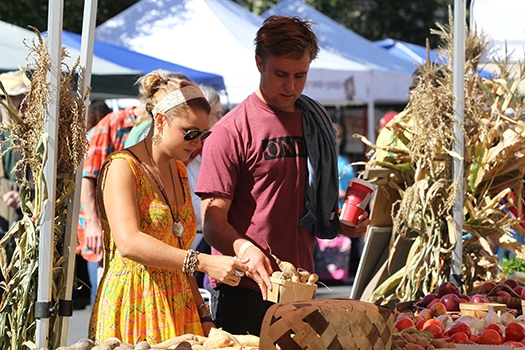On any given Sunday, the Schenectady Greenmarket is filled with members of the Union community.
Students, faculty and staff make the trip downtown to Jay Street when the market is outdoors in the summer and fall, and inside Proctor’s Theatre in the winter and spring. They browse and shop among the dozens of vendors offering an array of food, artisan goods and other items.
President David Harris visited the Greenmarket in October to meet with area residents about the College’s role in the local community.
“Union has been a strong supporter of the Schenectady Greenmarket,” said Cheryl Whilby, the market’s manager. “President Harris used this opportunity to get to know the customers, vendors, staff and volunteers. Students present that day also volunteered to help with market day tasks because we were shorthanded.”
The campus community’s support of the Greenmarket is just one way Union impacts the local economy. This impact is highlighted in the latest report by the Commission on Independent Colleges and Universities (CICU). Union contributed $313.1 million to the Capital Region economy in 2017. This included $21.8 million generated by its 2,200 students and thousands of visitors, according to the analysis done by the Center for Governmental Research. The center conducted the statewide study for the CICU.
With 871 employees and an annual payroll of nearly $60 million, Union is among the largest employers in the region. The College is also a major purchaser of goods and services in the community, as well as a source of vital construction and service contracts.
Recently completed projects include Ainlay Hall, the first phase of a $100 million project to create an Integrated Science and Engineering Complex; the Stanley O’Brien ’74 Center for Collaboration and Engagement, which is attached to Grant Hall; and the Feigenbaum Center for Visual Arts.
The College’s thousands of visitors come to campus each year for admissions tours, concerts, conferences, reunions, homecoming, exhibits, and sporting and other events. Many visitors are from out-of-town and stay in area hotels, dine in local restaurants and patronize local retail businesses.
Union has been recognized nationally for its positive contributions to the city of Schenectady, including real dollars invested through its foundations and annual budgets; the presence felt from payroll, research and purchasing power; and faculty and student involvement in community service.
Union is among the 100-plus private, not-for-profit colleges and universities that collectively generated $88.8 billion in economic activity for New York state in 2017, an increase of 12 percent since 2015.
The total represents the sum of three primary areas of spending – institutional impact, academic medical centers, and student and visitor spending. Institutional impact represents research, construction, instruction, salaries and spillover spending. Academic medical centers include patient revenue, the estimated benefits of residents and fellows, and other indirect and induced efforts of the center. Student and visitor spending has a significant impact on discretionary spending at restaurants, retailers and lodging facilities.
“New York’s private colleges are an integral part of the state’s economy, serving as major employers, anchor tenants and economic engines in every region of the state,” said Mary Beth Labate, CICU’s president. “This is particularly true upstate where our campuses create jobs and economic vibrancy in communities large and small. We are private colleges, but we are working to benefit the public good in a very real and important way.”
CICU is a statewide association representing the public policy interests of the chief executives of more than 100 independent colleges and universities in New York State.
